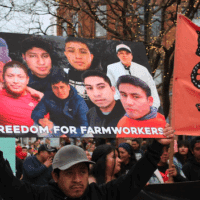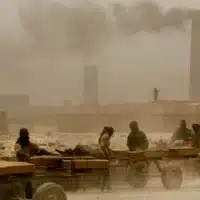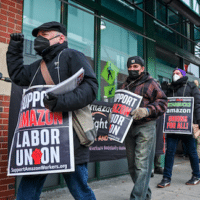-
Coalbrook: The Worst Mining Disaster in Africa
On the morning of January 21, 1960, 431 black and six white coal miners were entombed in a sudden collapse at Clydesdale Collieries near Coalbrook in Sasolburg, Free State Province.[1] The first rockfall took place at about 4:30 p.m. No one was killed or severely injured. While the rock still creaked and split, many of […]
-
No, You Aren’t Hallucinating, the Corporate Plan for AI Is Dangerous
Big tech is working hard to sell us on artificial intelligence, in particular what is called “artificial general intelligence.” At conferences and in interviews corporate leaders describe a not-too-distant future when AI systems will be able to do everything for everyone, producing a world of plenty for all. But they warn, that future depends on […]
-
Farmers protest unjust immigration system
If the President and his allies were serious about improving lives, they would back bills that reform our immigration system and protect the farm economy.
-
Workers’ revolution in Portugal, 1974-5
The country’s ruling class had operated for centuries by pillaging its colonies while neglecting to build much industry at home. Portugal was the least developed country in Western Europe; 37 percent of the population couldn’t read or write.
-
NATO-backed Ukraine escalates war on labor: Union leaders arrested, halls seized
Just over 11 years ago, fascist mobs cheered in central Kiev as the Federation of Trade Unions of Ukraine (FPU) roared with flame.
-
Global war on labor: Report says workers’ rights in freefall as right-wing power grows
Around the world, workers’ rights are in “freefall,” with the Trump administration in the lead of a global far-right alliance that’s waging a “global war on labor rights.”
-
Colonial mining fuels Israeli genocide: global protests target Glencore
Glencore, one of the world’s largest mining conglomerates at the confluence of worker exploitation, environmental destruction, and genocide, brought Palestine solidarity activists, trade unionists and mining affected communities together in a unified protest.
-
Starbucks sued for slave labor
Starbucks, the largest coffee chain in the world and the 120th richest corporation in the United States, is being brought to court after being exposed for using slave labor in their coffee production chain.
-
Iraq – Rising temperatures increasing poverty and unemployment
The contradiction in the geographical distribution of Iraq’s population precisely reflects the contradiction in the distribution of wealth in capitalist society.
-
Cops bust picket line as Teamsters strike seven Amazon warehouses
Amazon warehouse workers and delivery drivers at seven facilities in the metro areas of San Francisco, Chicago, Atlanta, Southern California, and New York City are out on strike Thursday, in what the union says is the largest strike against Amazon in U.S. history.
-
“Nothing like before” — China is out-competing the West on EVs
The West is accusing China of “overcapacity” to blame it for its own industrial demise.
-
The Labor Documentary Amazon probably doesn’t want you to see
‘UNION’ follows Amazon warehouse organizers through an uphill battle, a stunning victory, and an uncertain future.
-
Canada Post strikers are fighting for more than postal workers
The current strike by 55,000 Canada Post workers is about more than postal workers.
-
Will AI take over the world and all our jobs?
The general belief is that we already have or are on the cusp of creating machines that possess human-like intelligence which will be able to accomplish most tasks that humans can do, making a lot of us redundant and taking away a whole range of employment opportunities.
-
Honolulu nurses weather long lockout and win staffing ratio language
In a malicious ploy, a hospital in Honolulu locked out its nurses after a one-day strike—and not just for a couple days, as hospitals often do, but indefinitely. The message was, you can come back only when you accept our demands.
-
Contesting the idea of progress: Labor’s AI challenge
The material changes ushered in under the aegis of artificial intelligence (AI) are not leading to the abolition of human labor but rather its degradation. This is typical of the history of mechanization since the dawn of the industrial revolution. Instead of relieving people of work, employers have deployed technology—even the mere idea of technology—to […]
-
Health and safety: Amazon fails to deliver
“We are going to be Earth’s best employer and Earth’s safest place to work.” (Jeff Bezos, April 2021)
-
The Italian workers occupying against climate crisis
Faced with the threat of mass redundancies, GKN automotive workers in Florence occupied their factory to save jobs and build green technology. Their actions can be an inspiration to British workers fighting similar fights.
-
Rising costs but no pay rise: U.S. workers fight back
As the presidential election closes in, Jamal Elaheebocus reports on working class strike actions across the USA.
-
How U.S. union leaders worked with the CIA to undermine democracy
Soon after Israel launched its genocidal war in Gaza with the full support of the U.S. government, opposition emerged to the Biden administration in a place that many professional political commentators found confounding: within U.S. trade unions.




















